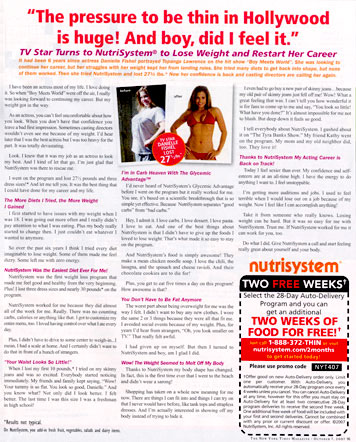
NutriSystem Advertisement, The New York Times Magazine, October 7, 2007
Being a design snob, I've always wondered why anyone with taste would pay thousands of dollars to publish one of those text-heavy, type-awful, full-page magazine advertisements void of any semblance of graphic design nuance or sophistication. In other words, an ad so terribly designed the word "design" is irrelevant. Then again, who would take the time to read a 2000-word promotional screed set in monotonous body type, full of hyped-up assertions couched in moldy clichés? Well, now I know at least part of the answer. I am that reader. And those advertisers must bank on the fact that design is indeed irrelevant when the sales message is its own virtue. Maybe they are right.
I came across such a full-page specimen in this past Sunday's The New York Times Magazine, opposite a page on which were the final runnover paragraphs of a fascinating article on Todd Haynes' biopic inspired but not about Bob Dylan, titled "I'm Not There." Having reached the end of the article, and ready to close my eyes for a short catnap, I saw the following headline: "The pressure to be thin in Hollywood is huge! And boy, did I feel it." Such announcements are usually typographic white noise, but then my eyes focused on the typical "before" and "after" pictures and I was hooked.
There was a small but incredibly sexy studio photograph of a woman wearing a bikini overlapping a bleached-out snapshot of her enormous previous incarnation. Although ordinarily not worth an additional iota of attention, this girl, it turned out, was 26-year old woman Danielle Fishel, who from 1993 to 2000 played Topanga Lawrence on the amusing sitcom, "Boy Meets World." Over the years she grew increasingly more sensual evolving from tween to teen. It was one of my then young son's favorite shows, which I dutifully sat through to monitor his intake of mass media. Now I (gladly) admit that watching her develop over the course of many seasons was not a burden. Once "Boy Meets World" was off the air, however, Topanga left my consciousness, until this past Sunday when I stumbled upon the advertisement shown here for NurtiSystem's Glycemic Advantage. By any standards it is a poorly designed ad, but nonetheless very effective. Design snobbery has its place, yet good design I have learned is often irrelevant in the pursuit of an audience.
I wasn't even in the market for a dietary program, but I was intrigued enough by the come-on to read every last sentence presumably written in Ms. Fishel's own words. "I have been an actress most of my life," she states in the first paragraph. "I love doing it. So when 'Boy Meets World' went off the air, I really was looking forward to continuing my career. But my weight got in the way." Poorly letter-spaced and forced-justification of default typefaces notwithstanding, I was hooked.
"Look," she continues as though in a direct conversation with me. "I knew that it was my job as an actress to look my best. And I kind of let that go. I'm just glad that NutriSystem was there to rescue me." And so was I, once her admission turned into a confession. "I first started to have issues with my weight when I was 18... I really didn't pay attention to what I was eating. Plus my body really started to change then. I just couldn't eat whatever I wanted to anymore."
The prose is not Proustian or even Judy Blumeian, nonetheless it seems pretty honest for an ad. So I found myself drawn from reading one short paragraph to another, until by the time the sales pitch kicked-in I was invested enough to continue reading the entire tract down to the coupon. Moreover, as I read, never once did I think of the type or layout: I just wanted to be convinced Topanga was on her path to nirvana, self-fulfillment, or at least another TV gig (you'll have to read the ad to find out).
Of course, I know this advertisement is deliberately "designed" to capture the attention of those who relate to celebrities who after years in the glamour limelight became fat (like that perky Valerie Bertinelli in those Jenny Craig commercials). "Dolling-up" the ads with elegant typefaces is therefore unnecessary since those before- and after-shots, and lengthy personal testimonials, do the job so well, regardless of layout. What's more, from a strategic branding point-of-view, running a text-heavy, sloppily-composed full-page in an otherwise handsomely designed magazine, replete with beautiful fashion and product advertisements, makes it stand out more. I also presume that if a company is investing this much money in a "direct response" ad, they must know what they are doing. Their audience is going to be engaged because of the celebrities sincere about their road back from perdition. Right?
In this blinkered era of design sophistication the lines between good and bad are actually not so clearly drawn. As we see on a daily basis, not all consumers care about good, great, or exceptional design when what they really want is to believe in the message. And the message NutriSystem may be telegraphing is this: Loose your excess weight NOW and worry about design later.
Still, call me an old design snob. We deserve better and so does Topanga.
